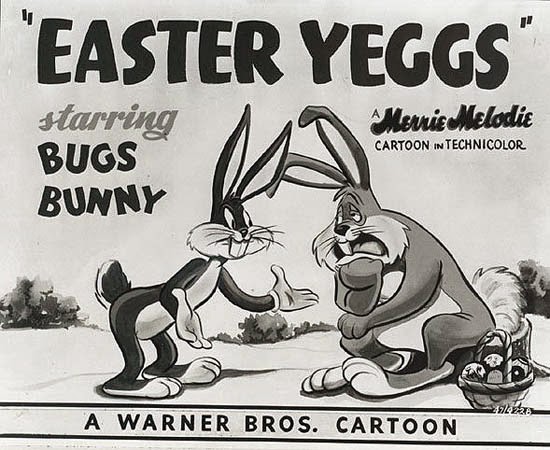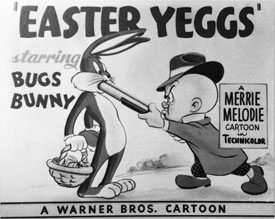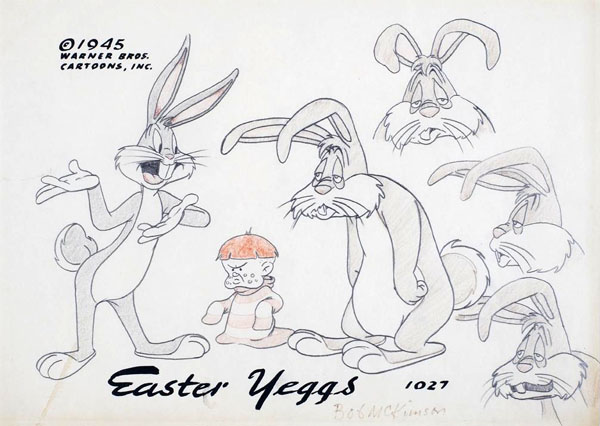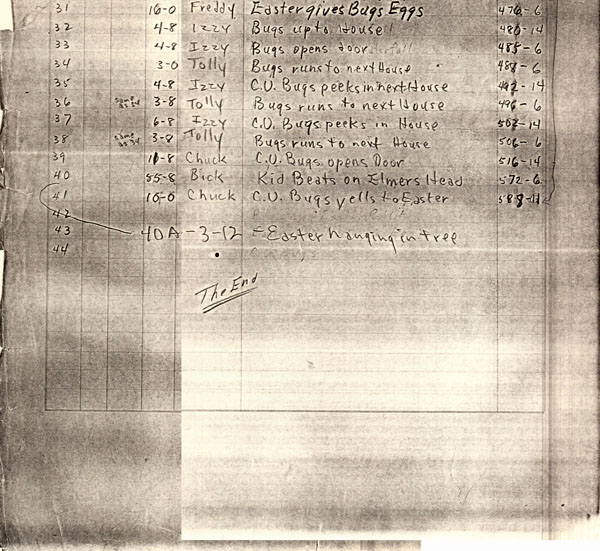
“Here’s the Easter Rabbit, hooray! The happy Easter Rabbit, hooray!”
While I was spending a week-long family vacation and enjoying myself out in the sun at Montego Bay in Jamaica, I often thought about the readers anxiously waiting for this next breakdown, especially for those who’ve listened to Jerry’s hint on his most recent Stu’s Show appearance. I suppose it’s necessary to say, “It’s da suspense dat gets me!”
 Disney’s Funny Little Bunnies (1934) and Lantz’s The Egg-Cracker Suite (1943) may more effectively represent the spectacle of the festivities, but Bob McKimson’s Easter Yeggs is undeniably the most memorable Easter cartoon from the Golden Age, disproving those extravagances. Bugs Bunny’s temporary stint delivering “Technicolor hen fruit” for the occasion is certainly one of the few Warners cartoons that many viewers outside of hardcore cartoon buffs remember, especially its memorable dialogue (“I wanna Easter egg! I wanna Easter egg! I wanna Easter egg!”)
Disney’s Funny Little Bunnies (1934) and Lantz’s The Egg-Cracker Suite (1943) may more effectively represent the spectacle of the festivities, but Bob McKimson’s Easter Yeggs is undeniably the most memorable Easter cartoon from the Golden Age, disproving those extravagances. Bugs Bunny’s temporary stint delivering “Technicolor hen fruit” for the occasion is certainly one of the few Warners cartoons that many viewers outside of hardcore cartoon buffs remember, especially its memorable dialogue (“I wanna Easter egg! I wanna Easter egg! I wanna Easter egg!”)
In the opening scenes of the cartoon, Bugs encounters an Easter Rabbit unable to continue – in actuality, shirking responsibility of — delivering Easter eggs. The voice and mannerisms were influenced by Mel Blanc’s characterm “The Happy Postman”, which he had performed on The Burns and Allen Show since 1942. Blanc’s inspiration for the distressed character was a homeless beachcomber in need of money who he once encountered. After Blanc lent him enough for food, the man replied, “God bless you, sir, and keep smiling” – part of which became the Postman’s farewell catchphrase during his appearances. By the time this cartoon was in production, the character’s voice became whinier. Here’s an excerpt from The Burns and Allen Show, aired on June 25, 1945:
Easter Yeggs is one of the earliest McKimson-directed entries where his younger brother Charles animated in his unit. He previously left Warners by late July, 1941 when he was assigned to the Photographic School and the Army’s Training Film Production Unit. In most of Charles’ scenes in this cartoon, Bugs is given thick eyebrows (examples: scs. 9 and 12), and handles his toothy laugh, which occurs twice in the cartoon, including the final shot. (There is no animator credit for the preceding aftermath of the explosive Easter egg, with the Easter Rabbit hanging lifelessly on a tree limb.)
Fred Abranz’s animation in this cartoon has some sharp timing. He handles the opening sequence in which Bugs fully absorbs and clutches his (assumedly ribald) “How to Multiply” book to his chest, upon hearing the Easter Rabbit’s cries. Abranz also handles Elmer’s introduction, at first speaking tenderly about the arrival of the Easter Rabbit, and with a quick turn, states his ulterior purpose, with a fervent “BANG! Easter Wabbit stew!” Izzy Ellis’ work in this cartoon is considerably weak, with rather poor inking/clean-up in some of his scenes; in scene 7, the drawing on Bugs wiping the egg from his face is disproportionately odd-looking. He handles both scenes of Bugs on his way to deliver the Easter eggs, the latter of which has a begrudging reprise — one of Blanc’s funniest dialogue readings.

No records survive of when the orchestral score was recorded for Easter Yeggs, but it’s speculated that it occurred approximately around September, 1946. Bea Benaderet performed a pick-up line that month for Tweetie Pie; both cartoons were in production close to each other, with their dialogue recorded in the same month. Herein lies something perplexing, but interesting about one of the music cues; the music for the “Easter Rabbit” ditty Bugs sings in the cartoon is similar to one sung by a pre-cursor of the rabbit in Hare-Um Scare-Um (1939), known as “I’m Going Cuckoo (Woo-Woo).”
Judging from original music cue sheets from other Warners cartoons that have used this melody (Porky in Egypt and Nutty News), it isn’t listed as a licensed song, but as their own music cues, credited to Carl Stalling, under different titles for each inclusion. (It’s listed as “The Voices” in Egypt; in Hare-Um Scare-Um’s cue sheet, it’s listed as two different titles in its orchestration, “Guessing Games” and “Mobbed,” named for their sequences.)
Have a happy Easter, everyone! Remember, keep smiling…


(Thanks to Michael Barrier, Keith Scott, Richard Finegan, and Jerry Beck for their help.)



 DEVON BAXTER is a film restoration artist, video editor, and animation researcher/writer currently residing in Pennsylvania. He also hosts a
DEVON BAXTER is a film restoration artist, video editor, and animation researcher/writer currently residing in Pennsylvania. He also hosts a 





















































































I remember the scene when Bugs grabbed the arm of the “juvenile delinquent ” (also voiced by Mel Blanc) he started screaming “OOOOOOOOOOH!!!!! THE BAD RABBIT BROKE MY LIL’ ARM!! THE BAD RABBIT BROKE MY LIL’ AAAARRRRMMMMMM!!!!!!!” Hence bringing out the parents and in laws of that little brat and Bugs bailed out quickly avoiding a hail of bullets that the family fired upon. And the finale where Bugs got his revenge on that Easter Bunny by using a booby trap egg and blowing him into kingdom come. There a scene that showed that tough little brat sucking on the muzzle of a gun like it was a pacifier I wonder if that scene got cut in future showings of Easter Yeggs? Fun Fact the tough little kid from Easter Yeggs was also in the Tiny Toon Adventures special Tiny Toons Spring Break Special now voiced I believe by Tress McNeill.
Not the best Bugs,but the brat yelling “I wanna Easter egg!” was a family favorite. It was something to yell when issuing a Dutch rub or similar indignity to a sibling’s head.
Or a “noogie”?
“I wanna Easter Egg” was also a family favorite refrain from the cartoon. My senior citizen kids, now 62 and 65 years old, still bring it up.
One of my favorites! I love the part where Bugs is angrily singing the Easter Rabbit song as he heads to Elmer’s house.
I love this cartoon but even as a kid I thought there was some pretty ugly Elmer Fudd faces in this one. And it’s always fun hearing a voice artist imitate one of their other characters, as Bugs does at the end.
Elmer’s probably at his nastiest here — even Yosemite Sam never wanted to kill the Easter Bunny and turn him into Sunday afternoon stew! — but it does solve the problem of justifying Bugs being mean to the next kid on the block after his previous unpleasant experience.
This is also one of those cartoons where McKimson experimented with character’s upper bodies pulling away from the screen, while leaving their lower half in place, but elongated. Along with some of his unusual choices for perspective shots, they made Bob’s late 40s cartoons stand out visually from everyone else’s. efforts.
Actually it was the bratty Dead End Kid who was mean to Bugs first by smashing the Easter Egg that Bugs gives him on his head,biting him on the ankle and manhandling him with several wrestling moves until Bugs finally fed up with the abuse that little brat gave him,grabs his arm by force and calls his a Juvenile Delinquent. But that brat started screaming and wailing in “dramarama” fashion: “THE BAD RABBIT BROKE MY LIL’ ARM!!!” thus bringing his parents and in laws armed with shotguns and Tommy guns and Bugs made a hasty retreat from there narrowing dodging the bullets as the peppered the door with the warning message “AND DON’T COME BACK”
Yeah, that’s what I meant by “his previous unpleasant experience.“. By 1945 all the Warners directors (even Bob Clampett in “The Big Snooze”) realized there had to be some provocation by Bugs’ opponent to make the audience root for all the things Bugs would do to his adversary for the rest of the cartoon.
In “Easter Yeggs”, Bugs is provoked by the Mean Wittle Kid down the block, but McKimson and Foster justify him taking it out on Elmer as soon as he enters the house by having Fudd tell the audience he plans to make Easter Wabbit stew. Elmer’s usually not that aggressive when we first meet him in any cartoon, but after six-plus years of getting it from Bugs, you can see why he might have developed a hostility to wabbits in general, and feeds into the holiday cynicism that makes people love the cartoon (just compare this to the saccharine ending McKimson and the others had to do 30 years later in “The Bugs Bunny Easter Special” — where’s that giant explosive Easter egg when you really need it?)
Between this and Freleng’s contemporary uses of Elmer (Stage Door Cartoon, Slick Hare and Hare Do in particular), you can see an attempt to make Elmer more competent and malicious, and thus more deserving of abuse than Jones or Clampett’s Elmer pictures.
This is a great cartoon because of how cynical and violent it is. And even if he comes out on top in the end, it’s interesting to see Bugs take so many lumps in spite of trying of do good.
Actually, that was Elmer’s shtick. He always hunted Bugs to make him into some dish. (He always failed but he tried.)
I especially like the part where Elmer is chasing Bugs, who slams the door and Elmer’s head crashes right through it. Quick-thinking Bugs then paints Elmer’s bald pate to look like a painted egg, and whistles for the nasty little kid, who leaps upon Elmer, grabbing his head and banging on it repeatedly as Elmer scrambles from the hole in the door and runs off down the street with the brat on his shoulders! I’d love to hear both recording sessions for this, and I wonder if all recorded elements still exist, including the repeated “I wanna Easter egg; I wanna Easter egg,” because it sounds, if you listen carefully, as if the kid goes off on some other kind of dialogue as Elmer screams “Ooh! No! Stop it!” The fact that most people remember this BUGS BUNNY cartoon above even the efforts by Disney tells me that Warner Brothers cartoons should never be forgotten! Okay, blame it on TV that we remember even the taboo entries, but Warner Brothers cartoons are by far teh funniest, because we can laugh at ’em as adults as well.
Actually, I listened to an interview with Bob Clampett and he said that WB cartoons were never meant to be viewed by children. If you watch a lot of the cartoons closely, especially during WW2, you’ll notice a lot of political statements and situations that a child would never understand.
“I can’t miss with my Dick Twacy hat!”
I still can’t believe that Elmer wore a “Dick Tracy” hat rather than his derby or hunting outfit in that one.
@BOB I’ve always thought that there was some backstory or inside joke behind the hat and Elmer’s line referring to it.
That layout sheet makes it look like an extension of Clampett. But since it was early in the game, I wonder if it could have been something inherited from that unit (though it’s using mostly the former Tashlin crew that McKimson took over).
Why aren’t of these older Bugs cartoons shown on Cartoon Network or Boomerang?
Due to “politically correctness” several of the older Bugs Bunny cartoons are not shown . At one time Cartoon Network and Boomerang had the June Bugs marathon where they shown all of the Bugs Bunny cartoons until politically correctness reared its ugly head and CN/Boomerang started to banned several Bugs Bunny cartoons (All This and Rabbit Stew,Herr Meets Hare,Which is Witch Doctor and Bugs Bunny Nips the Nips) and others had the disputed scenes censored (Southern Fried Rabbit,Hare Conditioning, 8 Ball Bunny,and others).
There are many reasons besides “political correctness”. Most importantly, CN is devoting its timeslots to newer shows such as Adventure Time, Gumball, Regular Show, We Bare Bears, and so forth. Boomerang, on the other hand, has been reformatted into an “international children’s network that will still showcase the classic WB, Hanna-Barbera, and MGM characters”. However, Boomerang’s programming has gone from MGM rarities and Hanna-Barbera nostalgia to something you’d expect to see on Nick Jr. and PBS Kids. Occasionally, CN and Boomerang will show Looney Tunes (a handful from the 50’s) and T&J, but they are usually stretched to fit 16×9 aspect ratio, and are also time-compressed. Also, the people at CN no longer value the historical importance and entertainment value of these shorts like they used to.
IMO, 2012 was the last great year for Boomerang, as they were still showing MGM shorts (all the Tex Avery classics and Harman-Ising rarities, although very late at night) and even B&W Popeye cartoons (minus the Paramount logos) during the DAY.
Looney Tunes were also available on CN at the time, though most of the shorts were character-driven and mostly from the 50’s (I did get to see Porky and Daffy, although digitally colorized).
As of June 2015, Boomerang of MEXICO was still showing Looney Tunes including Speedy Gonzales, and even Cool Cat! I remember while in Mexico in December 2014, they were mostly showing the pre-48 Looney Tunes, including the following shorts (dubbed in Español): Hiawatha’s Rabbit Hunt, A Feud There Was, Along Flirtation Walk, and many others.
To make a long story short, they pop up where you least expect them, even OUTSIDE the States.
Third reason besides the others is WB subsidiary, acting separately, Turner, versus Warner Brothers themselves. Easter Yeggs is from 1947 and THUS is Turner owned… something from say, late 1948 or 1950, directed by WB themselves..happy easter, and REMEMBER..a la Happyu Postman (also the source of Blanc’s Hardy Har Har vloice)…KEEP SMILIN!
Steve
Warner Bros. Cartoons still get shown on TV, these days, in the states, but they’re the same, cherry-picked 50’s WB shorts that Turner Broadcasting plays ALL the time. I mean, Turner currently holds the rights to all color cartoons copyrighted prior to Sept. 1, 1948 plus all black-and-white Harman/Ising Merrie Melodies except 1931’s “Lady Play Your Mandolin”. Warner owns all the rest, and both companies claim to own 1948’s “Odor of the Day”. I mean, if anything, I’d rather Turner rerun the Pre-1948 WB shorts edited, like how it was in the 90’s and early 2000’s than play the same 50’s WB shorts over and over again like they’re doing nowadays. It’s no wonder why you don’t see ‘Easter Yeggs’ on TV. There’s nothing ‘politically incorrect’ about “Easter Yeggs”.
“You’ll give the Easter Bunny a bad name!”
“I already got a bad name for the Easter Bunny!”
Don’t we all! 😉
@Hernandez2014
I remember the Looney Toon and Merrie Melodies in LATAM Spanish being broadcasted in the 1990’s before Cartoon Network and Boomerang premiered in Latin America. They were broadcasted on Mexico City’s Televisa owned XHGC TV 5 and on the cable network ZAS. XHGC had the “Blue Ribbon” (later the app issued for tv) Looney Toons/Merrie Melodies from the 1930’s early technicolor shorts (which were known in LATAM Spanish as “Fantasías Animadas de Ayer y Hoy” {Animated Fanatsies from Yesterday and Today} ) and the 1940’s including the WWII animated shorts to the 1950’s LT/MM shorts (announced by Bugs in LATAM Spanish as “Esto es una producción de la Warner Bros para televisión [This is a Warner Brothers production for television] ) which were redubbed by Turner Entertainment eliminating the “Fantasias Animadas de Ayer y Hoy” slogan in the 1990’s and ZAS had ABC’s Roadrunner Show (which had the 1960’s WB/MM shorts as well as the syndicated Porky Pig show and The Speedy Gonzalez Show.
My favorite of the LATAM Spanish LT/MM cartoons…the original dubs and not the Ted Turner redubbed versions are
Bugs Bunny Gets the Boid (aka El Heroe) and the sequel The Bashful Buzzard
I Wanna Be a Sailor (where the tough little parrot’s voice was done in a adult like gravel voice style instead of a boyish like voice)
A Star is Hatched
Naughty but Mice
And
The Dover Boys of Pimento University (which coincidentally both of the voices of the female lab mouse being held against her will and the voice of Aurora (Doris Stanpipe) was done by the same voice actress)
The ;lab mouse is Berenice Hansell and DOra is Marjorie Tarlton.,BUt MT DID play Sniffles.
I remember seeing a Spanish version of “Hair Raising Hare”. In the scene where Bugs is choked by Gossamer, Bugs is saying “Ey, no me ahorques, oigame.” just like the Eugenio Derbez character “Eloy Gameno”. I was ROTFL!!!!!
At some time in the early 1980’s, KMEX (Channel 34, Los Angeles), was showing the dubbed versions of the AAP package of “Merrie Melodies”. These had the Spanish dialogue dubbed over the soundtrack, which made everything sound confused, as you could still hear the English soundtrack underneath. These cartoons ended with one of the dubbed characters singing “Este Cuento se Acabo-o-o-o!” (“This story is ended!”)
At some time later in the 1980’s,, the same station was running “versiones doblados” (dubbed versions) of Hal Seeger’s “Batfink” cartoons. (His shtik was traslated “Tus balas no me hacen dan~o! Mis alas son como un escudo de acero!”)
(With this computer, I have no way of putting the tilde in its proper place.)
Like I stated earlier I’ve seen the original LATAM Spanish versions of the WB LT/MM cartoon shorts on Mexico City’s XHGC TV 5 but on other Mexican tv stations as well like on Telemax in Hermosillo Sonora and on XEJ TV 5 Ciudad Juarez Chihuahua. Also if you have a SAP feature on your tv you could hear the LATAM Spanish dub. Sometimes it was quirky hearing a totally different musical background soundtrack when the character were speaking. Not only the WB cartoons but also MGM,Walter Lantz and others had the different background soundtrack as well. BTW some of LT/MM Cartoons in LATAM Spanish did had the characters including Bugs Bunny singing “Esta Cuento se Acabo-o-o-o!! ” some of earlier Vitaphone LT/MM cartoons had a jester saying that in ,
LATAM Spanish but when the 1950’s LT/MM Cartoons were dubbed you can hear Bugs saying That All Folks in LATAM Spanish (Esto Todo Amigos).
Interesting to note that on the lobby cards the short is billed as a Merrie Melody, but on those (thankfully original) title cards the short was released as a Looney Tune.
One scene in this short I’m surprised doesn’t get lauded more often is the ‘magic trick’ scene, superbly animated by Charles McKimson. Blanc’s handling of the dialog in that brief scene is nothing short of astounding, heightened by that brief pause when Bugs looks at the results of the trick. It never fails to get a laugh from me.
I also like the way they managed to incorporate the Easter Rabbit into that sequence. Pulling him out of the hat makes sense in the context of the scene, and is a reminder to the audience of the cartoon’s roots while it’s off on a tangent. (Also, an unwelcome reminder to Bugs of the responsibilities he’s shirking while he’s goofing off with Elmer… I mean, trying to survive. 😉 )
Even though the correct production and scene numbers are written on the layout there are some suspicious things about it. The peg holes are not the same as the ones Warners used in their productions – the paper has been punched with east coast peg registration. The positioning of the artwork in relation to centre peg is strange – putting the artwork east of centre peg instead of drawing it at 5 field centre. And the artwork looks a lot bigger than 5 field…
Just caught up to this post – fantastic! Another dream come true! Who would have thought one of my all -time favorite scenes, Bugs tring to correct the juvenile delinquent, the OOH, HE BWOKE MY WIDDLE ARM reaction, and the zero frame appearance of the gun-toting guardians, was done by 2 animators I had never heard of till last year (and I’m almost 55 years old)! The strange camera viewpoints add a vertiginous effect to the already-rubbery animation. The humor ranges from the subtle (“I know a trick…I used to work in a magic act.”) to the unsubtle-and at the time of release, edgy (“I already HAVE a bad name for the Easter Rabbit! ) to the arcane (“I can’t miss with my Dick Twacy hat!) A masterpiece!
Don’t know if anyone’s still reading this post, as it’s a few months old, but I found the listing for this cartoon on the Belgian Society of Authors, Composers, and Publishers site (https://www.sabam.be/). It lists Milt Franklyn as composing the score for this cartoon, which is strange because supposedly he didn’t start composing until the early ’50s (his first credited score is “Bugs and Thugs”), and Carl Stalling is explicitly listed as composer in the opening credits.
Seeing as this came from what’s more-or-less an official source, is it possible that Stalling’s name was merely attached to this short because he was the studio’s main composer at the time, regardless of if he actually scored it?
I wish this short played during the Bugs-ter Weekend Marathon Boomerang aired in 2015, but sadly, it did not play despite being Easter related.